Nature: Can We Put a Value on it?
Posted on: March 24, 2022
We value nature. But can we put a value on nature?
Following the 26th annual global climate summit (COP26) last year, the question has never been more important. How do we value the natural world – is it financial, societal or cultural? This is at the heart of the dilemma facing the six characters in the book Valuing Nature: The Roots of Transformation – and by joining them in their journey we can understand what nature means to us, the value we ascribe to it, and with what values we appreciate it.
The UK Centre for Ecology & Hydrology partner with Routledge Books to create a unique graphic novel to share its research and findings when valuing nature.
Set around the premise of a motley group of undergraduates endeavouring to complete a university assignment on ‘nature in the modern world’, this book explores the meanings people assign to nature, how relationships between people and nature might be characterised, the many values systems people hold for the natural world and the options and approaches society can deploy to manage it. It also looks at the extent to which we need entirely new economic systems to protect and sustain nature.
Should we put a value on nature?
With scientists and policy makers assessing and debating our next steps, the impetus to “value nature” has never been more compelling.
How do we value the natural world? Is it a question of financial valuation, assessing natures ‘resources’ for their monetary worth? Or a societal value – how we, the citizens of the world, demonstrate how much we value nature in our care for it?
The UK Centre for Ecology & Hydrology explores just this in its Valuing Nature Programme. It aims to improve understanding of the value of nature both in economic and non-economic terms, and improve the use of these valuations in decision making. It considers the economic, societal and cultural value of nature, linking researchers with businesses, policymakers and practitioners. Its findings have formed the concepts explored by the characters in Valuing Nature.
Let’s join them in tackling these complex ideas and look at their recommendations for a sustainable future…
What does nature mean to us?
First our characters establish the different definitions of nature:
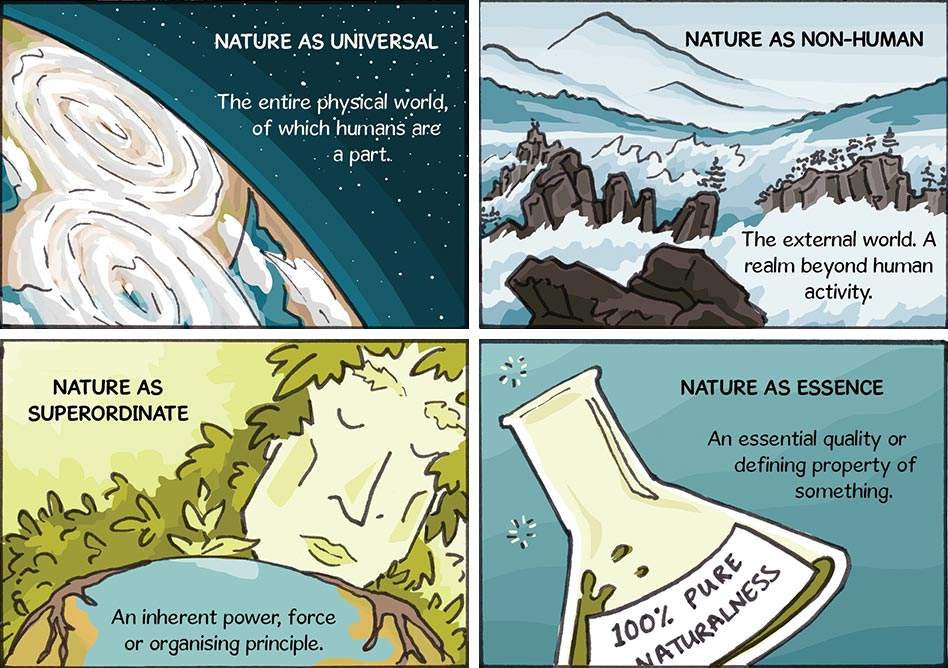
Understanding the ways that we can define Nature seems simple enough, but the relationship we have with it is more complex. Our own human relations to nature, in other words how we view and treat it, are having more impact now than ever. Here are the different ways the relationship between people and nature might be characterised:
• Masters of Nature is a perspective that nature is viewed as something to be tamed, controlled and exploited by humans for human benefit.
• Prisoners of Nature turns that logic on its head! This perspective suggests that nature actively shapes, structures, and limits the conditions of human life.
• And then there’s Affiliates of Nature, sometimes called the Biophilia perspective. It focuses on the way humans variously bond with, express affinity for, and associate with the natural world.
Assessing “nature in the modern world” and specifically the challenge of reconnecting people and nature has never been more important.
Why should we care about nature?
Our motley crew have plenty of debate amongst themselves as they try to figure out the many factors for consideration! They think about the difference between a valuation and values when we talk about ‘valuing nature’ and what it means to us. Author Rob Fish defines them as:
Valuation:
“The process of expressing and estimating the worth of something. Formal approaches to valuation in policy and decision making involve understanding the relationship between costs and benefits of a proposed change. This may have monetary and non-monetary dimensions.”
Values:
“Preferences, principles and virtues guiding conduct towards the world and the regard in which we hold things.”
These are important differences when we assess what valuing nature means, as our 6 students discover. The story told in “Valuing Nature” builds towards the assumption that value systems underpin the relations between people and nature. It considers what is meant by the term ‘values’, and the different types of values that might inform and guide conduct towards the natural world – in other words, the different reasons why we care about nature:
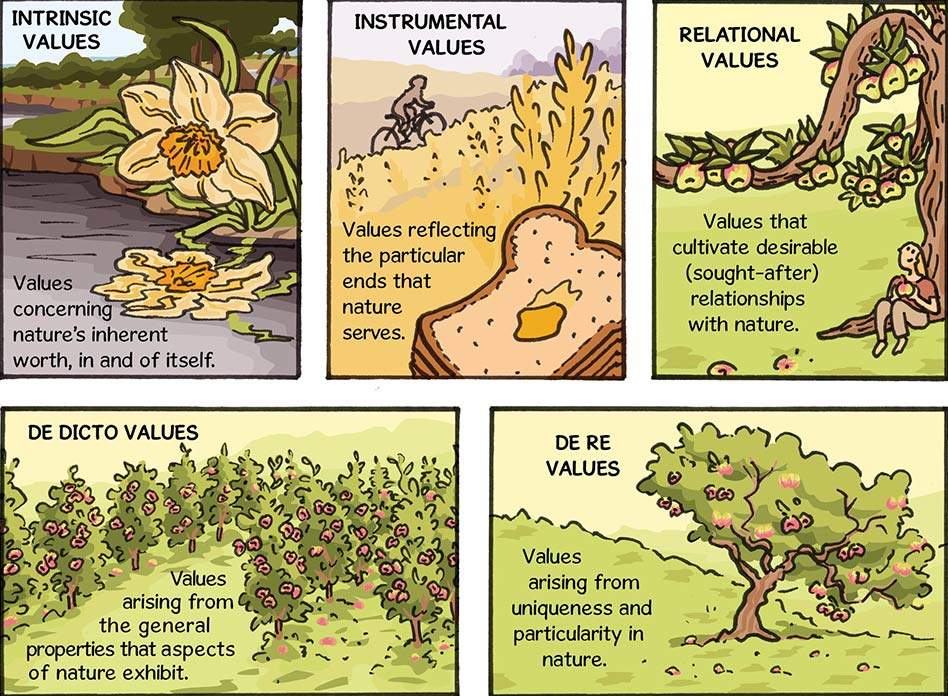
How does nature sustain our world as we know it?
Through ecosystems services. This is a concept used within sustainability science to describe natural systems in terms of their many and varied contributions to human well-being. ‘These contributions are understood to encompass the biophysical structures and processes that support basic human needs, secure livelihoods and enrich life culturally,’ explains author, Rob Fish.
The ecosystem services are grouped into 4 categories:
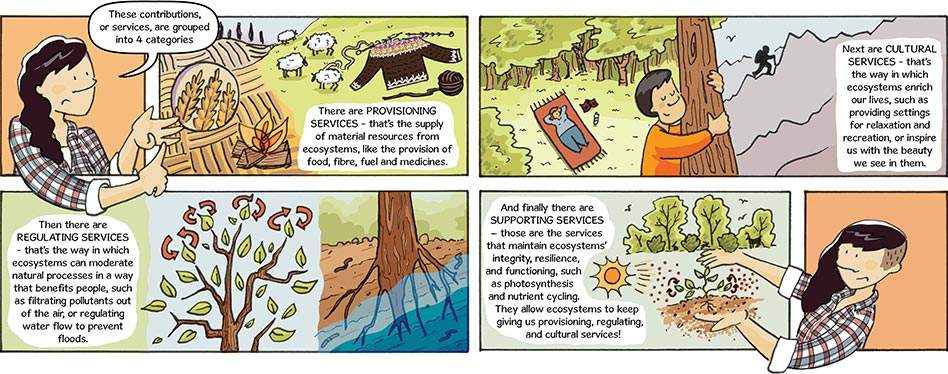
Whilst some might say we are reconnecting people to nature through the services it provides, others might find the whole idea of ecosystem services a bit cold and misleading at first glance; that surely it is more about having a connection at the human level!
And this is where the values come back into play – how you see the services depends on the values you hold, and your human relations to nature. Do we see ourselves as its Masters, Prisoners or Affiliates?
Because opinions will always have different influences, be they cultural, social, or political, our characters decide its better to regard humans as enrolled in a web of relations, what some have called the WEB OF LIFE: The interrelationships and interdependence of all living things. This interdisciplinary approach is interested in the relations that bind humans and non-humans together into one vast, interacting entity.
Making decisions in our management of nature:
So how do we use all this information to make informed decisions on our next steps to manage nature in a more sustainable way?
Our characters explore different models and approaches to the management of nature. They focus on urban and catchment ecosystems and the notion of a ‘biophilic’ city, where the Council is pitching for ‘biophilic status’; to be a city that conserves and celebrates nature in all its forms.
The students visit three different professors that help them consider the processes by which decisions are increasingly made through:
• ecosystem assessment (the scientific side of things)
• economic valuation (cost-benefit analysis)
• public participation (finding out what the people think)
They reconvene to exchange and discuss what they’ve learned. They discover that all these aspects depend upon one another:
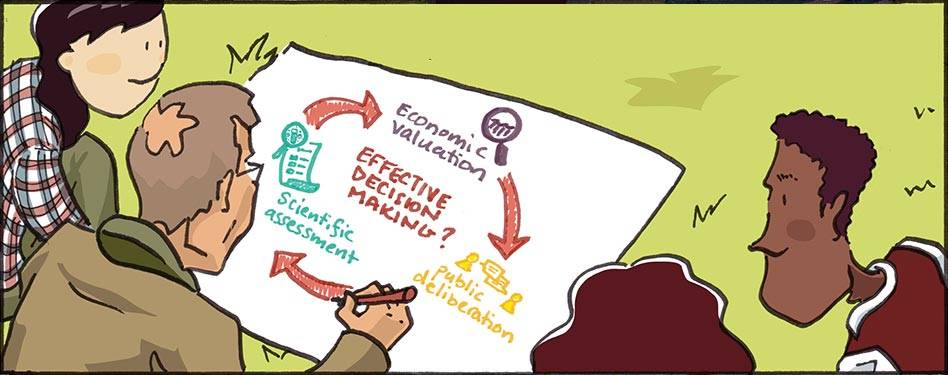
Action: putting sustainable solutions in place
Valuing Nature takes the reader on a whistle stop tour of ‘nature-based solutions’ around the world and shows how these ideas might be applied closer to home.
Feeling inspired, the students consider the practical implementation and funding of environmental management strategies. For the city to reach ‘biophilic status’ their bid will need to reflect the ‘latest scientific information’ and include a ‘full economic case as to why it pays to invest in nature’.
The book introduces and evaluates the role of market-based mechanisms (specifically Payments for Ecosystem Services), set within a debate about the role of state/non state action, as well as the diverse ways in which green finance can be enacted towards achieving environmental projects.
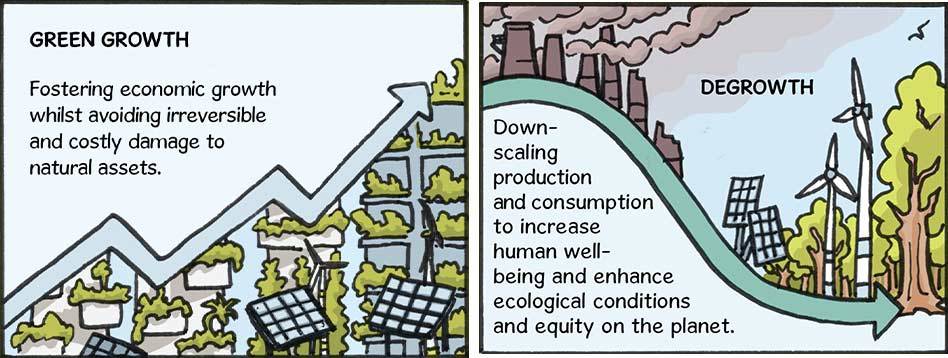
Who is responsible for nature‘s future?
This may well be the world’s best last chance to get climate change under control and reconnect with our planet before it’s too late. Scientists are increasingly asked to frame and value nature in terms of 'resources', which only serves to entrench the schism we have generated between ourselves and our environment.
This thought-provoking book intends to heal this separation wound, taking the reader on a journey on the valuation of nature – potentially the key to a truly sustainable future. It shows us why it is not just down to scientists to make meaningful change. As Professor Erik Swyngedouw puts it:
“Nature as the externally conditioning frame for human life - an externalization that permitted the social sciences and humanities to condescendingly leave the matter of nature to their natural science colleagues - has come to an end.” 1
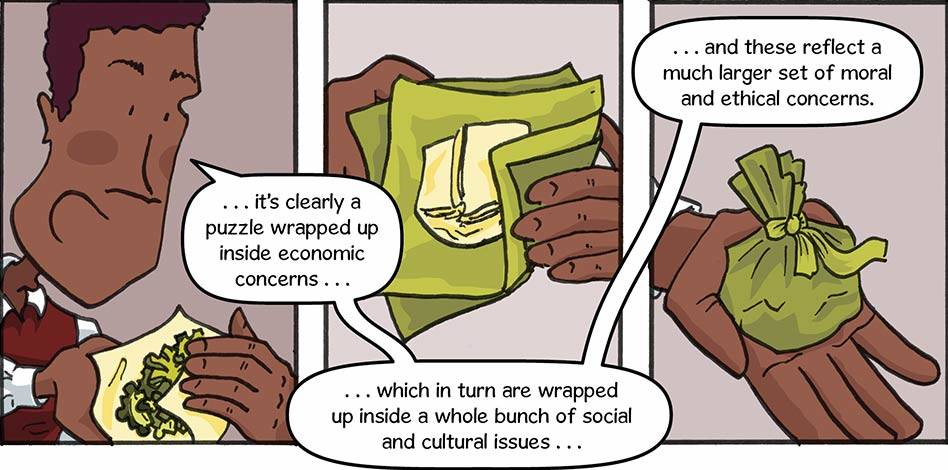
With a Glossary, Preface, Section Notes at the end and Critical Thinking Questions to deepen reflection, read this book via Open Access.

